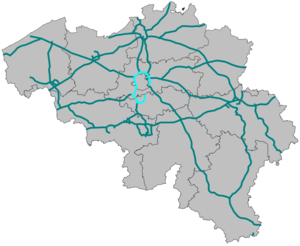Brussels Ring: Difference between revisions
TwinsMetsFan (talk | contribs) rm |
corrected typo 'Gote Bijgaarden' |
||
| Line 9: | Line 9: | ||
The '''Brussels Ring''' numbered '''R0''', is a [[beltway|ring road]] surrounding the city of [[Brussels]] as well as other smaller towns south of Brussels. The road is a circular highway road of about 75 [[km]] with 2 to 3 lanes in each direction. It crosses the 3 regions of Belgium: [[Flanders]], [[Brussels-Capital Region|Brussels]] and [[Wallonia]]. |
The '''Brussels Ring''' numbered '''R0''', is a [[beltway|ring road]] surrounding the city of [[Brussels]] as well as other smaller towns south of Brussels. The road is a circular highway road of about 75 [[km]] with 2 to 3 lanes in each direction. It crosses the 3 regions of Belgium: [[Flanders]], [[Brussels-Capital Region|Brussels]] and [[Wallonia]]. |
||
The first sections of the road were built in the late [[1950s]], but the main part was built during the [[1970s]], with the end of the construction in [[1978]]. The Brussels Ring has [[interchange (road)|interchanges]] with the European routes [[European route E40|E40]] (once at the |
The first sections of the road were built in the late [[1950s]], but the main part was built during the [[1970s]], with the end of the construction in [[1978]]. The Brussels Ring has [[interchange (road)|interchanges]] with the European routes [[European route E40|E40]] (once at the Groot-Bijgaarden interchange and once at the Sint-Stevens-Woluwe interchange), [[European route E19|E19]] (once at the Machelen interchange and once at the Ittre interchange), [[European route E411|E411]] (at the Leonard crossroad) and [[European route E429|E429]] (at the Halle interchange). It has also interchanges with national highways [[A12 road (Belgium)|A12]] (at the Strombeek-Bever interchange) and [[A201 road (Belgium)|A201]] (at the Zaventem interchange). |
||
== Course == |
== Course == |
||
Revision as of 16:57, 16 June 2011
| Ring R0 | |
|---|---|
| Brussels Ring | |
 | |
| Route information | |
| Length | 75 km (47 mi) |
| Location | |
| Country | Belgium |
| Highway system | |
| |
The Brussels Ring numbered R0, is a ring road surrounding the city of Brussels as well as other smaller towns south of Brussels. The road is a circular highway road of about 75 km with 2 to 3 lanes in each direction. It crosses the 3 regions of Belgium: Flanders, Brussels and Wallonia.
The first sections of the road were built in the late 1950s, but the main part was built during the 1970s, with the end of the construction in 1978. The Brussels Ring has interchanges with the European routes E40 (once at the Groot-Bijgaarden interchange and once at the Sint-Stevens-Woluwe interchange), E19 (once at the Machelen interchange and once at the Ittre interchange), E411 (at the Leonard crossroad) and E429 (at the Halle interchange). It has also interchanges with national highways A12 (at the Strombeek-Bever interchange) and A201 (at the Zaventem interchange).
Course
Starting from the Strombeek-Bever interchange with the A12, the Brussels Ring is located on the Grimbergen municipality. Going clockwise, the ring then crosses the municipalities of City of Brussels, Vilvoorde, Machelen, Zaventem, Kraainem, Wezembeek-Oppem, Tervuren, Auderghem, Watermael-Boitsfort, Hoeilaart, Waterloo, Braine-l'Alleud, Braine-le-Château, Halle, Beersel, Drogenbos, Forest, Sint-Pieters-Leeuw, Anderlecht, Dilbeek, Asse and Wemmel. In all 15 Flemish municipalities are crossed by the ring, 5 from the Brussels region and 3 from Wallonia.
Ramps
On top of having 8 interchanges with other highways, the Brussels Ring has 27 ramps numbered counterclockwise from 1 to 27:
- Ramp 1, also known as Quatre Bras/Vier Armen, leads to Tervuren
- Ramp 2 leads to Wezembeek-Oppem, Kraainem and UCL Saint-Luc hospital
- Ramp 3, also known as Zaventem-Henneaulaan, leads to Diegem and Zaventem
- Ramp 4 leads to Diegem-Woluwelaan, Vilvoorde, Evere and Zaventem
- Ramp 5 leads to Machelen
- Ramp 6 leads to Koningslo-Vilvoorde
- Ramp 7 leads to Grimbergen
- Ramp 8 leads to Wemmel, Expo, Strombeek-Bever, Laeken, A12-Willebroek
- Ramp 9 leads to Jette, Brugmann hospital and Merchtem
- Ramp 10 leads to Zellik, Aalst, Brussel, N9-Asse
- Ramp 11 leads to Sint-Agatha-Berchem and Groot-Bijgaarden
- Ramp 12 leads to Dilbeek
- Ramp 13 leads to Dilbeek, N8-Ninove, Sint-Jans-Molenbeek
- Ramp 14 leads to Anderlecht and Moortebeek
- Ramp 15 leads to Anderlecht and Pede
- Ramp 16 leads to Anderlecht and Sint-Pieters-Leeuw
- Ramp 17 leads to Anderlecht-Industries and Brussels-Centrum
- Ramp 18 leads to Ruisbroek, Drogenbos and Uccle-Stalle
- Ramp 19 leads to Lot and Beersel
- Ramp 20 leads to Huizingen and Alsemberg
- Ramp 21 leads to Halle and E429 Lille-Tournai
- Ramp 22 leads to Wauthier-Braine, Tubize and Waterloo
- Ramp 23 leads to Ophain and Braine-l'Alleud
- Ramp 24 leads to Nivelles, Lillois, Braine-l'Alleud and Parc de l'Alliance
- Ramp 25 leads to Genappe, Braine-l'Alleud
- Ramp 26 leads to Mont-Saint-Jean
- Ramp 27 leads to Waterloo-Centre


